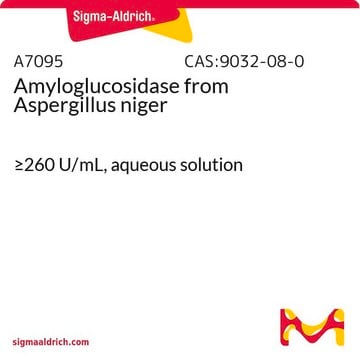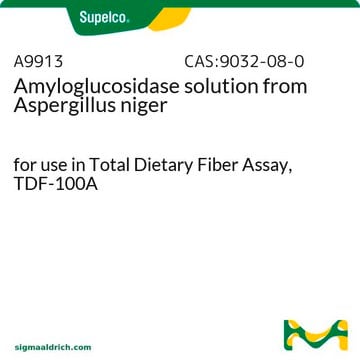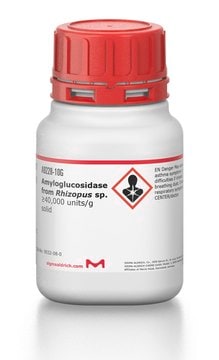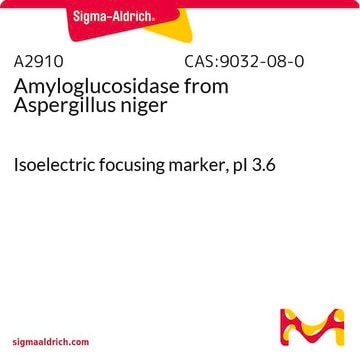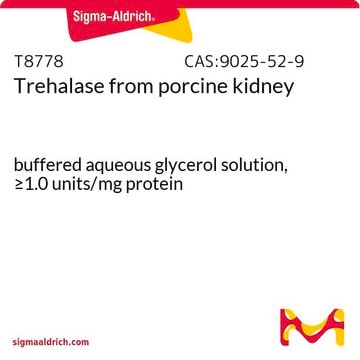This product is filled by density, with a target fill volume of 0.5 ml for the 25mg and 2.0 ml for the 100mg package sizes.
A1602
Amyloglucosidase from Aspergillus niger
ammonium sulfate suspension, ≥40 units/mg protein
동의어(들):
1,4-α-D-Glucan glucohydrolase, Exo-1,4-α-glucosidase, Glucoamylase
크기 선택
₩137,837
크기 선택
About This Item
₩137,837
추천 제품
양식
ammonium sulfate suspension
특이 활성도
≥40 units/mg protein
배송 상태
wet ice
저장 온도
2-8°C
유사한 제품을 찾으십니까? 방문 제품 비교 안내
일반 설명
애플리케이션
생화학적/생리학적 작용
단위 정의
물리적 형태
기타 정보
Storage Class Code
12 - Non Combustible Liquids
WGK
WGK 2
Flash Point (°F)
Not applicable
Flash Point (°C)
Not applicable
개인 보호 장비
Eyeshields, Gloves, multi-purpose combination respirator cartridge (US)
가장 최신 버전 중 하나를 선택하세요:
시험 성적서(COA)
이미 열람한 고객
문서
Instructions for working with enzymes supplied as ammonium sulfate suspensions
프로토콜
This procedure may be used for the determination of Amyloglucosidase activity using starch as the substrate.
-
What volume of ammonium sulfate is the 25mg suspended in?
1 답변-
도움이 되었습니까?
-
-
How can a 1mg/mL solution of amyloglucosidase A1602 be prepared in acetate buffer?
1 답변-
The product A1602 is in an ammonium sulfate solution. Here's how you can work with this product:
- If the ammonium sulfate might interfere with the reaction(s):
1. Remove the enzyme from the refrigerator, ensuring that the ammonium sulfate suspensions are not frozen.
2. Gently invert the vial or bottle to produce a milky suspension. Avoid using harsh treatments like vortexing or sonicating, as they may denature some of the enzyme.
3. Use a pipette and sterile wide-bore pipette tip to remove a portion of the suspension.
4. Transfer the portion to a clean microcentrifuge or centrifuge tube.
5. Pellet the enzyme by centrifuging at approximately 10,000 – 15,000 x g for 10 minutes, if possible, using a refrigerated microcentrifuge set to a temperature between 2 °C and 8 °C.
6. Carefully remove as much clear supernatant as possible, retaining it; it is not necessary to remove absolutely all of the ammonium sulfate solution.
7. Dissolve the pellet by adding an appropriate amount of reaction buffer.
8. Assay the supernatant and the solution from the pellet for protein content and/or enzyme activity.- If the ammonium sulfate will not interfere with the reaction(s), follow the same steps as above.
It's important to note that for an ammonium sulfate suspension, most of the enzyme will be in solid form, and only negligible amounts of enzyme will likely be in the ammonium sulfate solution.
Alternatively, there are several Amyloglucosidase enzymes available in solid form (e.g., Product A7420 and A9228) that can be suspended in a solvent of your choice.
도움이 되었습니까?
-
활성 필터
자사의 과학자팀은 생명 과학, 재료 과학, 화학 합성, 크로마토그래피, 분석 및 기타 많은 영역을 포함한 모든 과학 분야에 경험이 있습니다..
고객지원팀으로 연락바랍니다.